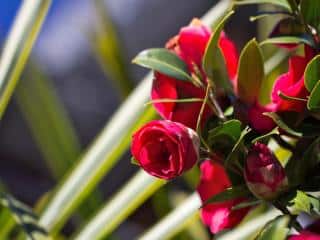

Camellia, a stunningly ornamental flower shrub, is perfectly suited to growing in pots. Picture it on your terrace or balcony!
Key Container Camellia facts:
Name: Camellia
Family: Theaceae
Type: flower shrub
Height in pot: 3 to 10 ft (1 to 3 m)
Exposure: part shade to full shade
Substratum: heath soil
Foliage: evergreen – Flowering: November to June, variety-dependent
Our tip: For container growing, go for smaller species, those not exceeding 3 ft (80 cm) tall at maturity. Here are tips to ensure your potted Camellia blooms year after year.
Whether in soil or a pot, Camellia needs good drainage. Soggy roots? No, thanks!
Whatever the container’s material, drainage is king!
Camellia in a pot will love heath soil for proper growth.
If you’ve picked a dwarf species, a simple maintenance pruning will do.
 Like most shrubs and potted plants, watering Camellia is a big deal. In pots, soil dries out much quicker.
Like most shrubs and potted plants, watering Camellia is a big deal. In pots, soil dries out much quicker.
Your Camellia might suffer and die if not careful.
Whether in a pot or in-ground, Camellia often encounters issues related to soil nature (usually too limey), or watering. These elements often cause leaf-level reactions.
This often occurs when soil drainage is poor, causing water to pool at root level.
End-of-winter fertilization with heather plant fertilizer helps fortify Camellia, improve blooming, and stave off diseases.
This is usually due to excess limestone in the soil, causing what is called Camellia chlorosis.
A mulch of pine bark on the surface a few inches thick (a few centimeters) solves many problems.
It helps prevent weeds, which also become easier to pull out.
→ Discover all our Camellia growing tips